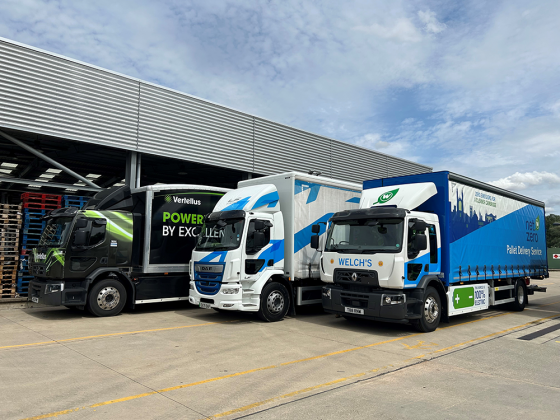Fleets urged to be wise in winter

During the winter months, it’s vital that companies employing drivers take extra steps to manage the risks and remind drivers of the dangers. Ross Moorlock, fleet director at road safety charity Brake, shares some tips
Winter is approaching fast and average temperatures are starting to plummet. The weather can be unpredictable and turn quickly, making roads treacherous. Ice, snow, heavy rain and fog significantly increase the risks on roads.
Stopping distances can double in the wet and increase ten‑fold in ice and snow, and if you can’t see clearly, you can’t react to hazards.
Driving in bad weather can be lethal. During the winter months, it’s vital that companies employing drivers take extra steps to manage the risks and remind drivers of the dangers.
This includes introducing appropriate policies, training and driver assessments as well as using the safest possible vehicles and ensuring they are rigorously maintained and fitted with appropriate safety features.
Drivers also have a responsibility to ensure they are as safe as possible and must work together with fleet managers to ensure everybody is well prepared.
Brake urges all fleet managers and drivers to follow the A, B, C of staying safe in winter and bad weather conditions.
Avoid driving
If weather conditions are severe or predicted to be severe or weather warnings have been issued, do not let drivers set out on a journey. It’s important for fleet managers and drivers to check weather forecasts and traffic news regularly for warnings of hazardous conditions.
If bad weather is expected, or has already started, consider whether to re-route or postpone a journey. Remember that certain conditions are more dangerous depending on road type.
Consider whether drivers might become stranded in remote locations and whether they will have to drive at night in bad weather, compounding the risk due to lower visibility.
Ensure all managers understand the risks of driving in dangerous conditions and always put safety first. Managers should instruct drivers who are already somewhere else to make an overnight stay if conditions are severe, rather than press on. Also ensure that a manager is always aware of drivers’ routes, schedules, location and expected times of arrival.
Be prepared
There are a few ways your drivers can prepare to remain safe if weather deteriorates when they are already on the road.
Make sure your vehicles are fit to drive in bad weather – vehicles should be regularly serviced and maintained. Regular checks by drivers are especially important in periods of bad weather. All drivers should carry out thorough walk-round checks at the start of every shift using a company walk-round check-list without fail and immediately report any defects or concerns.
Drivers must ensure there is anti‑freeze in their radiator and windscreen washer bottle and keep an ice-scraper and de‑icer in their vehicle at all times.
Keep emergency kits in your vehicles. This might include a torch, cloths, a blanket and warm clothes, food and drink, first-aid kit, spade, warning triangle, and high-visibility vest. Drivers should always take a well‑charged phone in case of emergencies, but must not be tempted to use it when driving.
Drivers should choose the safest route. Check forecasts and plan routes carefully. In bad weather, major roads are more likely to be cleared and gritted. Allow plenty of time for potential hold-ups and avoid minor rural roads where it will be difficult to seek rescue should drivers get stuck.
Careful, cautious driving
If your drivers do get caught in bad weather, they should follow these steps to minimise the dangers.
Slow right down: if visibility is poor or the road is wet or icy, it will take you longer to react to hazards and you should reduce your speed accordingly.
Take corners very slowly, and reduce speed further if your view of the road ahead is obscured. Always stay well within the speed limit and look out for temporary speed limit signs. Never speed up suddenly if fog seems to have cleared. Fog can be
patchy and you may suddenly re-enter it.
Maintain a safe gap behind the vehicle in front as that is your braking space in a crisis. In wet conditions you should leave four seconds, and in ice or snow, drop right back as much as possible. Stopping distances are double in the wet, and can be 10 times greater in icy weather. Never hang on someone else’s tail lights. This can provide a false sense of security and mean you’re not fully focused on the road.
Be extra vigilant for people and hazards, such as people on foot, bicycles, motorbikes and horses, which are harder to spot in adverse weather. Drive slowly and cautiously so you are able to spot vulnerable road users in plenty of time and not put them in danger. Look out for signs warning of hazards, people, adverse conditions or temporary lower speed limits.
Stay in control by avoiding harsh braking and acceleration, and carry out manoeuvres very slowly and with extra care.
Put lights on in gloomy weather and when visibility is reduced. Use front and rear fog lights in dense fog. Remember to switch off fog lights when visibility improves.
Snow and ice
If you get caught driving in snow and ice, use the highest gear possible to avoid wheel spin, but taking care not to let your speed creep up.
Brake gently to avoid locking the wheels. Get into a low gear earlier than normal and allow the speed of the vehicle to fall gradually.
Take corners very slowly and steer gently and steadily to avoid skidding. Never brake if the vehicle skids, instead, ease off the accelerator and steer slightly into the direction of the skid until you gain control.
If stuck in snow, do not spin the wheels or rev the vehicle, as this will dig the vehicle further in. Instead, put the vehicle into as high a gear as possible and slowly manoeuvre the vehicle lightly forwards and backwards to gently creep out.
If you are stuck fast, stay in the vehicle unless help is visible within 100 yards. Do not abandon your vehicle as this can hold up rescue vehicles.
Rain and floods
Follow these tips if you get caught driving in heavy rain and floods. Keep well back from the vehicle in front as the rain and spray makes it difficult to see and be seen.
Look out for steering becoming unresponsive, which can happen if water prevents the tyres from gripping. If this occurs, ease off the accelerator and gradually slow down. If possible, pull over somewhere safe until the rain stops and the water drains away.
Never attempt to cross a flooded road if you are unsure how deep it is; only cross if you can see the road through the water. Apart from potential damage, many vehicles require only two feet of water to float.
If driving on a flooded road, stay in first gear with the engine speed high and drive very slowly. Do not drive through floodwater if a vehicle is coming the other way. If possible, drive in the middle of the road to avoid deeper water near the kerb.
Test brakes immediately after driving through water by driving slowly over a flat surface and pressing the brakes gently. Warn passengers first.
In high winds and winter sun
In high winds, take extra care passing over bridges or on open stretches of road exposed to strong winds. If your vehicle is being blown about, slow right down and take great care to maintain a steady course.
Keep well back from motorcycles and high-sided vehicles as they can be particularly affected by turbulence.
Meanwhile, in winter, dazzle from low sun can be dangerous. Keep a pair of sunglasses in the vehicle all year round (prescription if needed) and keep your windscreen clean. Wear your sunglasses in bright sunshine, especially if the sun is low or reflecting off a wet road.






